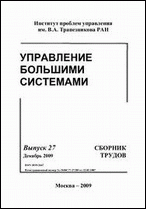|
Systems Analysis
An optimal itinerary generation of large intellectual agent groups
D. Yu. Maksimov
V.A. Trapeznikov Institute of Control Sciences of Russian Academy of Sciences, Moscow
Abstract:
Intelligence is represented in the Artificial General Intelligence (or Universal AI) approach as an information processor which consumes and gives out information. This information completely determines the system behavior. M. Hutter has obtained an optimal agent trajectory selecting in an abstract environment within this approach. However, the method demands number assessments of the reward in such a movement, and the way to obtain these assessments was not defined. The method does not also fit to estimate an agent group movement. In this paper, reward assessments are represented by the environment. The way to choose a trajectory for an agent group is also suggested. A group of intelligent agents which fulfill a set of tasks in parallel is represented by the tensor multiplication of corresponding processes in the Conway game category. The category corresponds to the environment and agents' moves. An optimal itinerary of the group is defined as a play with maximal total reward in the category. The reward is represented as a degree of certainty (visibility) of an agent goal, i.e., by some set, not a number. It is proved that such a reward determination may be used in the categorical construction of Conway games. The tensor product in the category is the operation of linear logic. Such logic is also used in selecting goals which the system can achieve of all visible ones. In the purpose, the whole goal set is represented as a lattice with the linear logic structure. The goal lattice is the truth value set of the logic in this case. The tensor product of the lattice elements corresponds to goals which are achieved in parallel. The system goals are chosen by the highest truth value of the lattice element which corresponds to they parallel achieving processes. Such a construction results in the formula of the optimal itinerary estimation in an abstract environment for an agent group.
Keywords:
intelligent agents; itinerary choice; goal lattice; game semantics.
Received: November 15, 2018
Published: March 31, 2019
Citation:
D. Yu. Maksimov, “An optimal itinerary generation of large intellectual agent groups”, UBS, 78 (2019), 46–70
Linking options:
https://www.mathnet.ru/eng/ubs992 https://www.mathnet.ru/eng/ubs/v78/p46
|

| Statistics & downloads: |
| Abstract page: | 193 | | Full-text PDF : | 93 | | References: | 35 |
|




 Contact us:
Contact us: Terms of Use
Terms of Use
 Registration to the website
Registration to the website Logotypes
Logotypes








 Citation in format
Citation in format 